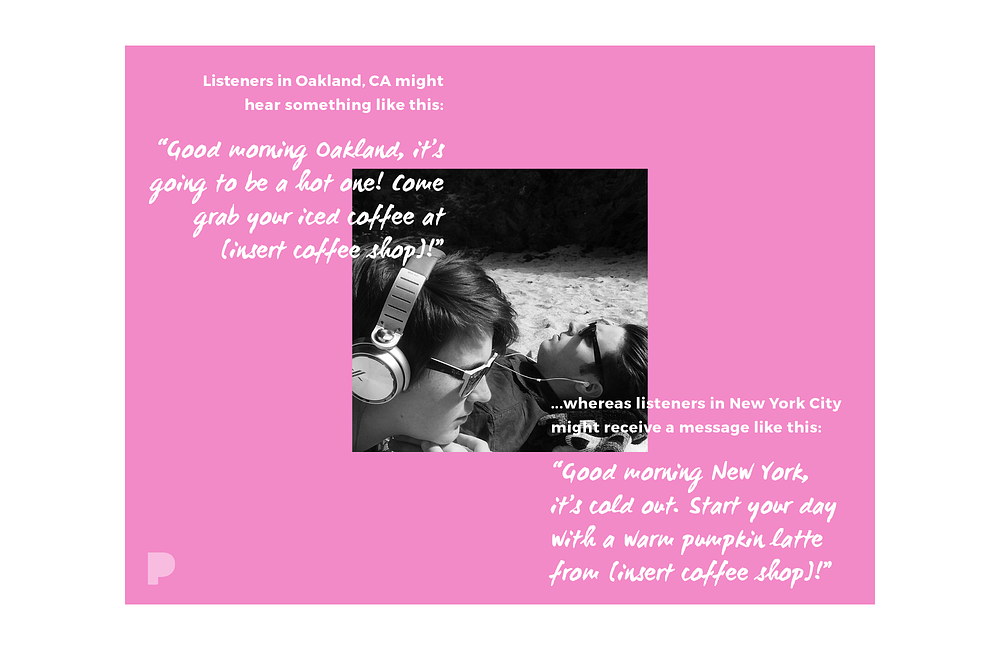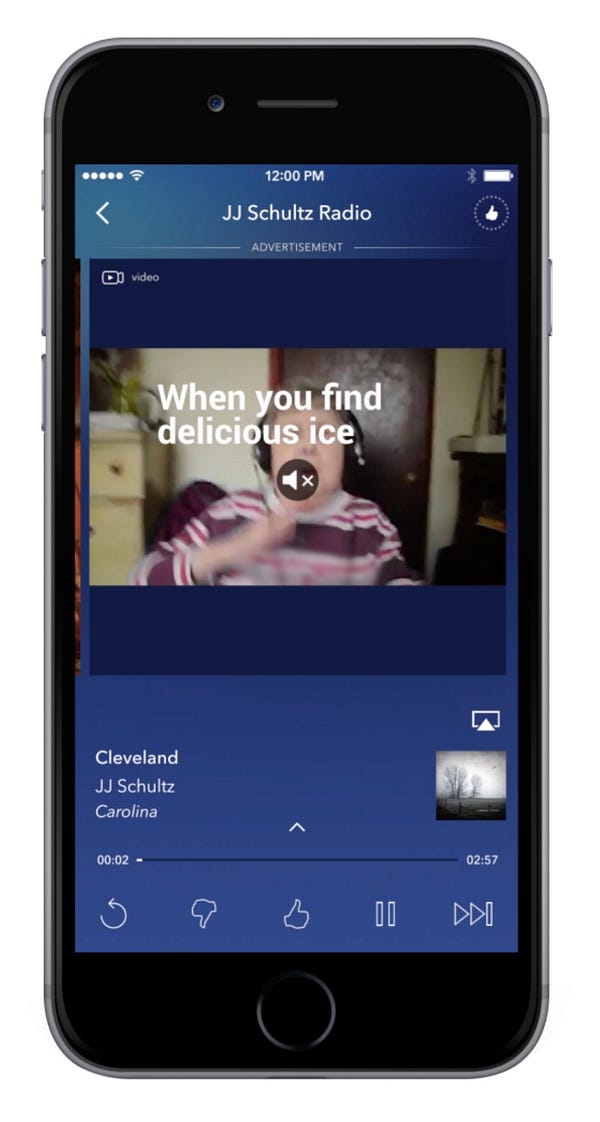Understanding Personalized Audio Ads On Pandora and How They’re A Game Changer For Music (And Other) Marketers
The music industry is fairly familiar with the music side of Pandora. But there's another side of the streamer that also presents a powerful opportunity – the ad platform monetizes its free radio service and a new partnership that delivers personalized targeted audio ads.
________________________
By Glenn Peoples, Music Insights and Analytics of Pandora
Key takeaway: in creating more personalized, dynamic audio ads, new technologies can impact not just Pandora’s free radio service but the company’s entire business as well as its stakeholders.
The music industry knows the music side of Pandora well. Royalties, licensing negotiations, executive changes, quarterly earnings and new products are widely covered in the media. And because Pandora is a publicly traded company, the industry has a fairly transparent view inside. Less seen is the innovative advertising side of the company that powers the free radio service. Peruse the Pandora for Brands website and you can see a constant drumbeat of news about advertising products built to attract brands and provide more value to advertisers. The success of a radio service, which paid $610 million in royalties last year, depends on these innovations.
The drumbeat continues. Last week Pandora announced an exclusive partnership with A Million Ads, a UK-based company that specializes in creating dynamic advertising for audio, that will help Pandora experiment with creating more personalized, relevant and effective digital ads. Chief revenue officer John Trimble said A Million Ads’ “tailored, data-driven audio creative in real-time gives us yet another way to help advertisers unlock the power of audio.” The two new audio capabilities — not yet available to advertisers, by the way— are “real-time personalized creative at scale” and “sequential messaging and targeting.”
Let’s stop for a moment and break down the terms that describe the new audio capabilities. First, “real-time personalized creative” means Pandora could experiment with ads that are personalized for a listener based on attributes like gender, age and zip code, while also taking into account factors like the weather, time of day and the listener’s location. In addition, through the work of Pandora’s data scientists and third-party data, additional listener attributes can be inferred. For example, a democrat is more likely to use T-Mobile or Sprint and listen to jazz, soul, funk, reggae and gospel. Doing it “at scale” means Pandora will be able to roll out these multi-variant ads to 81 million monthly listeners, a group large enough that advertisers can reach those specific groups of listeners most likely to respond to a brand’s message.
For years it has been possible to personalize advertising messaging by using targeting and building multiple ad creatives, but here’s how this is different: With A Million Ads’ technology combined internal listener data, Pandora can explore how to stitch together in real time multiple parts — or variants — of audio ads to create a single, personalized ad a single ad. Different voiceovers will be created for each variant so that each advertisement will be seamless. For example, the ad could open with a “Good morning” or “Good afternoon” depending on the time of day, place the listener in a specific city (Los Angeles or New York), mention the weather (“it’s going to be a hot one” or “it’s cold out”), give a call to action (“come grab your iced coffee” or “start your day with a warm pumpkin latte”), and close with the name of the coffee shop doing the advertisement. Because this ad has three variants, Pandora would serve eight different versions. The math is 2 x 2 x 2 = 8, or 2 (the number of options for each variant) to the power of 3 (the number of variants).

The other term, “sequential messaging and targeting,” describes the practice of serving a series of ads in a particular order to tell a brand’s story. For example, a listener might first be exposed to a general branding ad, second to an ad with more specific information, and finally to an ad that encourages email sign-ups. Using a sequence of ads to guide consumers through a funnel — from general message to specific call-to-action — achieves better results than serving a series of ads set periods of time. This was the finding of a 2014 study by Facebook, Adaptly and Refinery29. Compared to the sustained ads, sequential ads had far more success with the final ad’s encouragement to subscribe to Refinery29’s email list.

Pandora owns a few points of differentiation when using sequential messaging. Owning listening data for tens of millions of monthly listeners, and a listening history going back nearly 11 years, gives Pandora an advantage over other audio services in giving marketers the best possible results. In addition, Pandora doesn’t rely on cookies to identify listeners. Cookies worked best in the days a person browses the web on a single computer. But now people use a variety of devices throughout a day, from a PC at work to a mobile phone away from home and a tablet when at home. Because listening requires a log-in regardless of the device, Pandora can accurately determine when a particular person should hear a specific ad.
The experimentation with A Million Ads technology is part of a larger strategy of audio advertising innovation. Earlier in January, Pandora debuted muted video and responsive display ads—“a big hit with marketers,” wrote AdWeek—that play while a person is interacting with the Pandora app and listening to music, the goal being to connect a brand with the emotional state a listener feels when hearing a favorite song. In 2015 the company unveiled Sponsored Listening, which provides a user with either one or four hours of uninterrupted listening in exchange for engagement with a brand’s video or other media content for at least 15 seconds. And then last year, Pandora rolled out a new ad format for mobile video and display that fits into a song’s album art.
New ad products have implications outside of ad revenue. The ad-supported, free radio service is the foundation for Pandora Plus, the ad-free subscription service, and Pandora Premium, the $9.99-a-month, premium service with on-demand features that will debut this month. (Think of advertising as the bottom of a three-layer pyramid.) Pandora is unique for using an ad-based, audio service as a customer acquisition tool. To that point, 70 percent of the 465,000 net new Pandora Plus subscribers added from its mid-September launch through January were acquired on-platform. That same foundation of free radio listeners will also be used to efficiently acquire Pandora Premium subscribers. And so a more successful ad-based radio service that keeps people listening will create a more solid foundation that benefits all Pandora stakeholders.
To understand Pandora’s advertising business is to appreciate how the bills get paid, so to speak. Innovations in Pandora’s ad technology play an important role in building the music business. Even after the launch of the Pandora Premium subscription service later this month, ad-supported radio will continue to be Pandora’s most popular product. Everything, from the subscription services to Pandora’s live events to artist’s ability to reach listeners and sell concert tickets, is built on Americans’ love of free radio.
As for the country-listening mom living somewhere in the South who just dropped the kids at school on a typically hot, humid summer morning (as mentioned in the title), these new technologies can give her the right ad at the right time in the right season for the right product. Right?